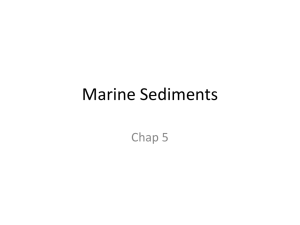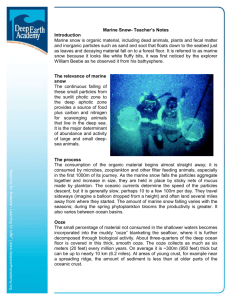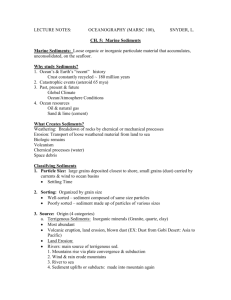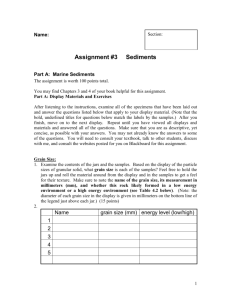Unit 4 Overview
advertisement
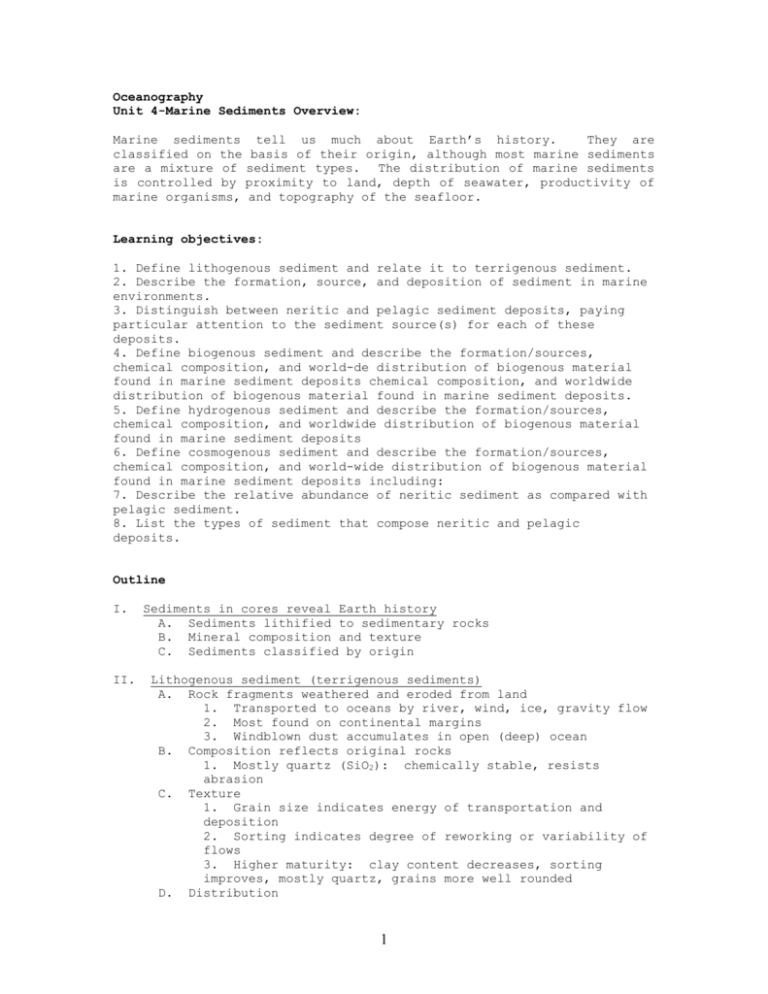
Oceanography Unit 4-Marine Sediments Overview: Marine sediments tell us much about Earth’s history. They are classified on the basis of their origin, although most marine sediments are a mixture of sediment types. The distribution of marine sediments is controlled by proximity to land, depth of seawater, productivity of marine organisms, and topography of the seafloor. Learning objectives: 1. Define lithogenous sediment and relate it to terrigenous sediment. 2. Describe the formation, source, and deposition of sediment in marine environments. 3. Distinguish between neritic and pelagic sediment deposits, paying particular attention to the sediment source(s) for each of these deposits. 4. Define biogenous sediment and describe the formation/sources, chemical composition, and world-de distribution of biogenous material found in marine sediment deposits chemical composition, and worldwide distribution of biogenous material found in marine sediment deposits. 5. Define hydrogenous sediment and describe the formation/sources, chemical composition, and worldwide distribution of biogenous material found in marine sediment deposits 6. Define cosmogenous sediment and describe the formation/sources, chemical composition, and world-wide distribution of biogenous material found in marine sediment deposits including: 7. Describe the relative abundance of neritic sediment as compared with pelagic sediment. 8. List the types of sediment that compose neritic and pelagic deposits. Outline I. II. Sediments in cores reveal Earth history A. Sediments lithified to sedimentary rocks B. Mineral composition and texture C. Sediments classified by origin Lithogenous sediment (terrigenous sediments) A. Rock fragments weathered and eroded from land 1. Transported to oceans by river, wind, ice, gravity flow 2. Most found on continental margins 3. Windblown dust accumulates in open (deep) ocean B. Composition reflects original rocks 1. Mostly quartz (SiO2): chemically stable, resists abrasion C. Texture 1. Grain size indicates energy of transportation and deposition 2. Sorting indicates degree of reworking or variability of flows 3. Higher maturity: clay content decreases, sorting improves, mostly quartz, grains more well rounded D. Distribution 1 1. 2. III. IV. Neritic deposits in shallow seawater a. Mainly lithogenous b. Beach sands c. Continental shelf deposits d. Turbidite deposits e. Glacial deposits Pelagic deposits in deeper seawater a. May include distal turbidite deposits b. Abyssal clay Biogenous sediment A. Hard parts of once-living organisms 1. Macroscopic--large shells, teeth, bones 2. Microscopic--small shells (tests) accumulate to form ooze, mainly plankton a. Ooze 30% or more biogenic material (by weight) B. Composition 1. Calcium carbonate, CaCO3, calcite or aragonite, calcareous ooze a. Planktonic microscopic protozoann, foraminifers b. Planktonic microscopic algae, coccolithophores (nannoplankton) 2. Silica, opal, SiO∙nH2O, siliceous ooze a. Planktonic microscopic algae, diatoms b. Planktonic microscopic protozoans, radiolarians C. Distribution 1. Controlled by productivity, destruction (dissolution), dilution 2. Neritic deposits a. Carbonate deposits (limestone) i. Modern environments: shallow, warm ocean water b. Stromatolites i. Cyanobacteria produce layered carbonates ii. Hypersaline 3. Pelagic deposits a. Siliceous ooze (diatomaceous, radiolarian, or silicoflagellate ooze) i. Below areas of surface ocean upwelling (high biologic productivity) b. Calcareous ooze (foraminifer, coccolith, pteropod, ostracod ooze) i. CaCO3 dissolves in deeper, colder, CO2-rich ocean ii. Lysocline and CCD (calcite compensation depth) iii. Carbonate ooze shallower than about 4500 m Hydrogenous sediment A. Precipitation of dissolved material in seawater B. Manganese nodules commonly layered about a nucleus; mainly Mn and Fe 1. Generally found in deep ocean 2. Mode of formation is not known C. Phosphate sediments associated with high biological productivity in surface waters 1. Shallower than 1000 m 2 D. Inorganic carbonates precipitate without life 1. Ooids (aragonite) in shallow tropical seawater 2. Concentric layers, wave agitation E. Metal sulfides associated with hydrothermal vents F. Evaporites form when seawater evaporates (halite, anhydrite, gypsum) 1. Areas of restricted inflow of seawater 2 High rates of evaporation V. VI. VII. Cosmogenous sediment A. Microscopic spherules and macroscopic meteorite debris from outer space B. Glassy tektites and Fe-Ni micrometeorites Mixtures A. Most marine sediments are mixed B. One sediment type is dominant Summary of distribution of neritic and pelagic deposits A. Neritic sediments influenced by latitude 1. Silt and clay found everywhere, decreasing percentages from equator toward poles 2. Coarse particles (gravel) dominate at higher latitudes 3. Sand found everywhere, most abundant at midlatitudes, decreasing percentages from midlatitudes toward equator and poles 4. Coarse coral reef debris found at low latitudes B. Pelagic sediments 1. Biogenous calcareous oozes most common on relatively shallow deep-sea floor a. Cover about 48% of seafloor 2. Biogenous siliceous oozes associated with areas of surface ocean upwelling b. Cover about 14% of seafloor 3. Lithogenous silt and clay most common in deeper parts of ocean floors c. Cover about 38% of seafloor 4. Deeper Pacific Ocean has relatively more abyssal clay than shallower Atlantic and Indian Oceans 3

